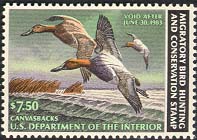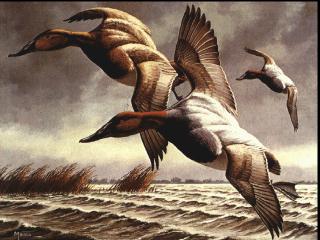

Back to RW49 Back to the Federal Index Home
A LITTLE HISTORY ON THE 49TH (1982-83) DUCK STAMP ARTIST


Gene Hill has long had an eloquent way of putting into words what every sportsman and dog lover has felt many times. In A Gallery of Waterfowl and Upland Birds, a book of recollections of birds, bird dogs, and hunting companions, however, a picture by David Maass is truly worth a thousand words for summing up the feelings of the hunter. It seems only fitting, therefore, that Mr. Maass is culminating several very productive years of wildlife art with the publication of the book.
The text is truly excellent and is highlighted in each chapter by Mr. Maass' oil paintings and pencil sketches. The end result of their collaboration truly reflects the mutual respect that the two great men have for each other. The book is a cover-to-cover pleasure, but it really couldn't miss with great painting as and great writings by two of the best in the field. The book was more than a milestone in Mr. Maass' career. It was also a great pleasure and he looks forward to doing it again.
Mr. Maass' book capped off an exciting set of works that started when he won the federal Duck Stamp contest in 1974. Minnesota, a state known for its wildlife artists, honored him by asking him to design their first Duck Stamp in 1977. Mr. Maass featured the most universal of ducks, Mallards, rising from the marsh on the painting he created for the stamp. The design set a record when it was issued in an edition of prints which numbered 3,200 copies.
The Ruffed Grouse Society also enlisted the services of Mr. Maass for the design of the 1980 Ruffed Grouse stamp and print. Mr. Maass is undoubtedly most recognized for his paintings of waterfowl. He treats the Ruffed Grouse with such knowledge and respect that the results on the canvas are every bit as moving an inspiring as the best of his waterfowl painting.
That same year he worked for yet another conservation organization, creating Monarch of the Hardwoods to raise funds to construct a research center for the National Wild Turkey Federation. Mr. Maass was presented with the Conservationist of the Year Award when the painting and the prints from the original raised nearly $200,000 for the Federation. Because the print sales from Monarch of the Hardwoods were so spectacular, the Federation asked Mr. Maass to paint the original for the 1981 Wild Turkey stamp print, and met with similar success. Print sales skyrocketed.
To his list of ducks, grouse, buzzards, and turkeys he added quail when he was chosen by the International Quail Foundation to design the first stamp for their program. The group is still a relatively new conservation organization, but is strongly dedicated to improve and protect all species of quail. their program got off to a great start when Mr. Maass' painting of three Bobwhites in flight raised over $130,000.
--------------------THE ART--------------------
Canvasbacks was done in full-color oil paints. The print is photolithography in four colors with special lightfast inks on Rag Cote paper. The print is hand signed and numbered in pencil. The edition in 22,250 and 400 artist proofs. The image size is 6-1/2" x 9". This is David Maass' second design win.
--------------------THE STAMP--------------------
Canvasbacks…Engraved by the Federal Bureau of Engraving from the original artwork. Printed in yellow, orange, green, purple, brown, and black ink. The stamp sold for seven dollars and fifty cents. Postal records show 1,926,253 stamps sold. First day of sale was July 1, 1982.
Most of the information contained above is from the book Federal Duck Stamp Story, Fifty Years of Excellence, by Laurence F. Jonson; Alexander & Co. It is used here with permission from the author. For more information on this book, please click here.